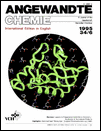31P CP/MAS NMR Spectroscopy of Transition Metal Phosphane Complexes: “J-Recoupling” between Chemically Equivalent 31P Nuclei in Polycrystalline Compounds of the Type trans-[(PR3)2MX2], MPd, Pt†
This work was supported by the Deutsche Forschungsgemeinschaft and the Fonds der Chemischen Industrie. We thank Degussa AG, Hanau, for their loan of precious metal salts and Dr. W. Weigand, Universität München, for compounds 2d, e. Prof. D. Michel, Leipzig, kindly provided access to the MSL 500 spectrometer.
Abstract
Minor modification—large effect: Replacement of Et3P by nBu3P in otherwise homologous complexes of the type 1 can dramatically change the solid-state NMR properties. The reason is that–although both compounds show 31PA2 spin systems in solution–only in one case are the 31P nuclei also magnetically equivalent in the solid state. Therefore a reliable interpretation of the high-resolution solid-state 31P NMR spectra must take into consideration the orientation-dependent interactions within the 31P spin pair.





